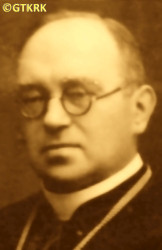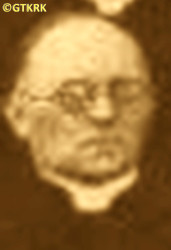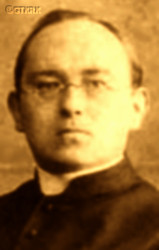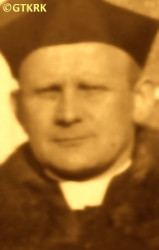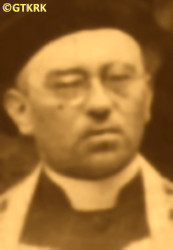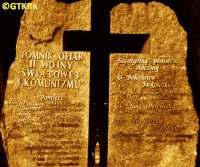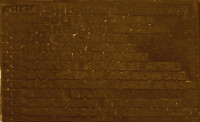Roman Catholic
St Sigismund parish
05-507 Słomczyn
85 Wiślana Str.
Konstancin deanery
Warsaw archdiocese, Poland
full list:
displayClick to display full list

searchClick to search full list by categories
wyświetlKliknij by wyświetlić pełną listę po polsku

szukajKliknij by przeszukać listę wg kategorii po polsku

Martyrology of the clergy — Poland
XX century (1914 – 1989)
personal data
surname
JAŚKOWSKI
surname
versions/aliases
JAŚKOWIAK
forename(s)
Boleslav (pl. Bolesław)
function
diocesan priest
creed
Latin (Roman Catholic) Church RCmore on
en.wikipedia.org
[access: 2014.09.21]
diocese / province
Gniezno and Poznań archdiocese (aeque principaliter)more on
www.archpoznan.pl
[access: 2012.11.23]
RC Military Ordinariate of Polandmore on
en.wikipedia.org
[access: 2014.12.20]
honorary titles
honorary canonmore on
en.wikipedia.org
[access: 2014.11.14]
(1934, St Peter and St Paul the Apostles and Nativity of the Blessed Virgin Mary RC collegiate church, Kruszwicatoday: Kruszwica gm., Inowrocław pov., Kuyavia‐Pomerania voiv., Poland
more on
en.wikipedia.org
[access: 2021.07.18])
„Medal of Independence”more on
en.wikipedia.org
[access: 2019.02.02]
(20.07.1932)
Ten Years of Independence Medalmore on
pl.wikipedia.org
[access: 2019.10.13]
date and place
of death
10.11.1939

Zajezierzetoday: Gniewkowo gm., Inowrocław pov., Kuyavia‐Pomerania voiv., Poland
more on
pl.wikipedia.org
[access: 2021.12.19]
details of death
During the Prussian partition (one of three partitions of Poland), as a student of the Germ. Königliches Gymnasium (Eng. Royal Gymnasium) in Wągrowiec, was a member of the clandestine, Polish self–education Thomas Zan Society.
During theological studies, president of the main council of the Polish Youth Association in Poznań — a community that became famous for defending young people against Germanization.
As a minister and catechist in Strzelno during Prussian times (partitions of Poland) every Sunday secretly taught Polish children Polish songs.
When on 09.11.1918, the German Emperor William II Hohenzollern abdicated; when two days later 11.11.1918, the Entente Allies and Germany signed an armistice and ceasefire in a staff carriage in Compiègne, at the headquarters of French Marshal Ferdinand Foch — which de facto meant the end of World War I; when on that same 11.11.1918 the Regency Council — operating in the territory of occupied by the Central Powers (Germany and Austria–Hungary) so‐called Germ. Königreich Polen (Polish Kingdom) — transferred supreme command over the army to Brigadier Joseph Piłsudski and appointed him Commander‐in‐Chief of the Polish Army, which de facto meant the rebirth of the Polish state, covering however mainly the area of Germ. Königreich Polen, i.e. the Polish territory under Russian rule until 1915, but excluding the lands of the Prussian partition, including Greater Poland — formally Prussian Germ. Provinz Posen (Eng. Poznań Province) — still formally part of the German state; ministered in Zduny, a town in the Germ. Kreis Krotoshin (Eng. Krotoszyn County) in the Germ. Province of Posen, located on the border with the Germ. Provinz Schlesien (Eng. Province of Silesia). At that time — when new centres of power were being formed everywhere in Germany — on 17.11.1918 became a member of the entirely Polish District People's Council established in Krotoszyn, founded on the appeal of the Supreme People's Council established in Poznań (earlier, on 12.11.1918, a Workers' and Soldiers' Council was established in Krotoszyn, modelled on a similar one in revolted Berlin, in which Poles constituted only 25% of the membership). At the same time, prob. a local People's Council was established in Zduny, and became its chairman. At that time, among other things, it i.a. managed to restore religious education in schools in Polish. Both sides however were preparing for a clash that would decide the statehood of the area.
On 27.12.1918, the Greater Poland Uprising broke out in Poznań. As early as 01.01.1919, the Polish District People's Council took over power in Krotoszyn by force of arms — thanks to the entry into the town of an armoured train from Kalisz, with an insurgent unit from Pleszew on board, and thanks to its negotiation skills. On 03.01.1919, his parish Zduny was captured by another insurgent group from Jarocin — the front line reached the historic border between Greater Poland and Silesia. A People's Guard was established then in Zduny, of which became the commander. At the end of 01.1919, however, the Germans began attacks on Zduny. On 03.02.1919, the Polish front command, considering the defence of the town impossible, withdrew most of the 250‐strong Polish crew. On 06.02.1919 the Germans unexpectedly attacked and took Zduny, eliminating the Polish defense (17 insurgents were killed, 40 were taken prisoner). Using Zduny as a base of operations, the Germans attempted to capture Krotoszyn, but without success. The Polish counterattacks failed — the last, bloodiest attempt took place on 16.02.1919 (the Germans used artillery, gas, gas shells, and even mine throwers).
Did not leave his parish and was arrested by the Germans. Accused of transmitting light signals from the church tower to Polish soldiers, refusing to make the parish hall available for quartering German soldiers. Released however but spied on and harassed by the Germans from then on. The Germans retained control over Zduny — even when the Uprising ended on 16.02.1919 with the armistice in Trier, enforced by the victorious Entente states, by virtue of which the Polish insurgent Greater Poland Army was recognized as an allied army and a border was set, which „German troops were forbidden to cross”, leaving a large part of Greater Poland outside their influence. Zduny found itself beyond the demarcation line, marked on 08.03.1920, on the German side.
Then undertook diplomatic action. Sent a memorandum to the victorious Entente powers, arguing for the Polishness of Zduny, which the Polish embassy in Paris took advantage of at the peace talks in Versailles. When a peace treaty with Germany was signed on 28.06.1919 and Greater Poland was awarded to Poland, even though the precise border line was to be determined by the international Delimitation Commission, Zduny was recognized as Polish. The treaty came into force on 10.01.1920, after the necessary ratifications, and a week later Zduny and the entire Krotoszyn district became part of Poland.
During the times of II Republic of Poland (till 1939) defended the rights of his German parishioners to say masses and celebrate prayers in German.
After German invasion of Poland on 09.1939 (Russians invaded Poland 17 days later) and start of the World War II, after start of German occupation, arrested by the Germans on 10.09.1939.
Jailed in Inowrocław prison.
Tortured.
Murdered in Gniewkowo forest in a mass execution of approx. 500 Poles and Jews.
Corpses were drenched with petrol and set alight.
cause of death
mass murder
perpetrators
Germans
sites and events
ZajezierzeClick to display the description, InowrocławClick to display the description, «Intelligenzaktion»Click to display the description, Ribbentrop‐MolotovClick to display the description, Pius XI's encyclicalsClick to display the description, Greater Poland UprisingClick to display the description, Thomas Zan SocietiesClick to display the description
date and place
of birth
19.12.1884Birth certification on:
metryki.genbaza.pl
[access: 2025.08.19]

Łobżenicatoday: Łobżenica gm., Piła pov., Greater Poland voiv., Poland
more on
en.wikipedia.org
[access: 2021.06.20]
parents
JAŚKOWSKI Francis
🞲 ?, ? — 🕆 ?, ?

SPRENGER Severina
🞲 ?, ? — 🕆 ?, ?
baptism
28.12.1884Birth certification on:
metryki.genbaza.pl
[access: 2025.08.19]

Łobżenicatoday: Łobżenica gm., Piła pov., Greater Poland voiv., Poland
more on
en.wikipedia.org
[access: 2021.06.20]
Holy Trinity RC church
presbyter (holy orders)
ordination
14.02.1909

Gnieznotoday: Gniezno urban gm., Gniezno pov., Greater Poland voiv., Poland
more on
en.wikipedia.org
[access: 2021.12.18]
Assumption of the Blessed Virgin Mary RC archcathedral churchmore on
en.wikipedia.org
[access: 2025.03.14]
positions held
1926 – 1939
parish priest — Inowrocławtoday: Inowrocław gm., Inowrocław pov., Kuyavia‐Pomerania voiv., Poland
more on
en.wikipedia.org
[access: 2021.07.18] ⋄ St Nicholas the Bishop and Confessor RC parish (main parish) ⋄ Inowrocławtoday: Inowrocław gm., Inowrocław pov., Kuyavia‐Pomerania voiv., Poland
more on
en.wikipedia.org
[access: 2021.07.18] RC deanery — also: editor of the „St Nicholas Parish Monthly”; founder of the Catholic League and Catholic Action; president of the Trade Union Council of the Association of Young Polish Women, the Society of Polish–Catholic Workers; vice‐president of the Union of Polish Associations; member of the boards of the Maritime and Colonial League, the Union of Priests „Unitas”; co‐founder of the Allotment Gardens Society
1918 – 1926
parish priest — Zdunytoday: Zduny gm., Krotoszyn pov., Greater Poland voiv., Poland
more on
en.wikipedia.org
[access: 2022.02.03] ⋄ St John the Baptist RC parish ⋄ Krotoszyntoday: Krotoszyn gm., Krotoszyn pov., Greater Poland voiv., Poland
more on
en.wikipedia.org
[access: 2021.07.18] RC deanery — In recognition of services, awarded the title of Honorary Citizen of Zduny
1917 – 1918
vicar — Witkowotoday: Witkowo gm., Gniezno pov., Greater Poland voiv., Poland
more on
en.wikipedia.org
[access: 2021.07.18] ⋄ St Nicholas the Bishop and Confessor RC parish ⋄ Gniezno Holy Trinitydeanery name
today: Gniezno urban gm., Gniezno pov., Greater Poland voiv., Poland
more on
en.wikipedia.org
[access: 2021.12.18] RC deanery
1914
administrator — Strzelnotoday: Strzelno gm., Mogilno pov., Kuyavia‐Pomerania voiv., Poland
more on
en.wikipedia.org
[access: 2021.07.18] ⋄ Holy Trinity RC parish ⋄ Kruszwicatoday: Kruszwica gm., Inowrocław pov., Kuyavia‐Pomerania voiv., Poland
more on
en.wikipedia.org
[access: 2021.07.18] RC deanery — acting („ad interim”)
1912 – 1917
vicar — Strzelnotoday: Strzelno gm., Mogilno pov., Kuyavia‐Pomerania voiv., Poland
more on
en.wikipedia.org
[access: 2021.07.18] ⋄ Holy Trinity RC parish ⋄ Kruszwicatoday: Kruszwica gm., Inowrocław pov., Kuyavia‐Pomerania voiv., Poland
more on
en.wikipedia.org
[access: 2021.07.18] RC deanery — also: president of the Society of Industrialists
1911 – 1912
vicar — Gnieznotoday: Gniezno urban gm., Gniezno pov., Greater Poland voiv., Poland
more on
en.wikipedia.org
[access: 2021.12.18] ⋄ St Michael the Archangel RC parish ⋄ Gniezno St Michael the Archangeldeanery name
today: Gniezno urban gm., Gniezno pov., Greater Poland voiv., Poland
more on
en.wikipedia.org
[access: 2021.12.18] RC deanery — substitute
1909 – 1911
vicar — Chomiąża Szlacheckatoday: Gąsawa gm., Żnin pov., Kuyavia‐Pomerania voiv., Poland
more on
en.wikipedia.org
[access: 2022.02.03] ⋄ St John the Baptist RC parish ⋄ Żnintoday: Żnin gm., Żnin pov., Kuyavia‐Pomerania voiv., Poland
more on
en.wikipedia.org
[access: 2021.06.20] RC deanery
1909
vicar — Parlintoday: Dąbrowa gm., Mogilno pov., Kuyavia‐Pomerania voiv., Poland
more on
en.wikipedia.org
[access: 2021.07.18] ⋄ St Lawrence the Martyr RC parish ⋄ Żnintoday: Żnin gm., Żnin pov., Kuyavia‐Pomerania voiv., Poland
more on
en.wikipedia.org
[access: 2021.06.20] RC deanery
1909
vicar — Łagiewniki Kościelnetoday: Kiszkowo gm., Gniezno pov., Greater Poland voiv., Poland
more on
en.wikipedia.org
[access: 2021.12.18] ⋄ Corpus Christi RC parish ⋄ Janowiectoday: Janowiec Wielkopolski, Janowiec Wielkopolski gm., Żnin pov., Kuyavia‐Pomerania voiv., Poland
more on
en.wikipedia.org
[access: 2021.07.18] RC deanery
till 1909
student — Gnieznotoday: Gniezno urban gm., Gniezno pov., Greater Poland voiv., Poland
more on
en.wikipedia.org
[access: 2021.12.18] ⋄ philosophy and theology, Archbishop's Practical Theological Seminary (Lat. Seminarium Clericorum Practicum)
from 1905
student — Poznańtoday: Poznań city pov., Greater Poland voiv., Poland
more on
en.wikipedia.org
[access: 2021.07.18] ⋄ philosophy and theology, Archbishop's Theological Seminary (Collegium Leoninum)
from 1916
membership — Poznańtoday: Poznań city pov., Greater Poland voiv., Poland
more on
en.wikipedia.org
[access: 2021.07.18] ⋄ Friends of Sciences Society
others related
in death
FIEDLERClick to display biography Sigismund
sites and events
descriptions
Zajezierze: In Zajezierze forests, not far from Gniewkowo, Germans murdered approx. 4,000 Poles, as a part of «Intelligenzaktion» aimed at extermination of Polish intelligentsia and ruling classes in Pomerania. In one day, on 10.11.1939, day before Polish Independence Day, Germans murdered there more than 500 Poles setting alight their bodies. (more on: pl.wikipedia.orgClick to attempt to display webpage
[access: 2012.11.23], ipn.gov.plClick to attempt to display webpage
[access: 2016.05.30])
Inowrocław: German prison and detention center at Pakoska Str. (today Narutowicza Str.). In 1939, the Germans held there hundreds of Poles from Inowrocław and the surrounding area, arrested as part of the «Intelligenzaktion» program — the physical extermination of the Polish intelligentsia and leadership classes. By 11.1939, 546 of them were murdered in the prison and the surrounding area (e.g. in Rożniaty and Zajezierze), including 56 people on the night of 22‐23.10.1939, the murder carried out after the collective libation of the Germans, which the German landrat, i.e. the occupying district official, a certain Hirschfeld, was said to have initiated by saying: „well, now we will go and shoot the Poles”. Later, it was also a place of execution for many Poles. After the Russian occupation began in 1945, the communist prison, also for women. (more on: www.inowroclawfakty.plClick to attempt to display webpage
[access: 2013.05.19])
«Intelligenzaktion»: German: «Intelligenzaktion» (English: „Intelligence Action”) — a German program of extermination of the Polish elite, mainly the intelligentsia and leadership layers, carried out from the beginning of the occupation in w 09.1939 to 04.1940, mainly in territories directly annexed to Germany, but also in the so‐called Germ. Generalgouvernement (Eng. General Governorate), where it was called «AB‐aktion». In the first phase, immediately after the beginning of the German occupation, during military operations carried out by the Germ. Wehrmacht (Eng. Armed Forces) and the genocidal units of the Germ. Einsatzgruppen (Eng. Operational Groups) of the Germ. Sicherheitspolizei (Eng. Security Police), i.e. SiPo, and Germ. Sicherheitsdienst des Reichsführers SS (Eng. Security Service of the Reichsführer SS), i.e. SD, organized by the Germ. Reichssicherheitshauptamt (Eng. Reich Main Security Office), i.e. RSHA, which followed the troops, carried out under the Germ. Unternehmen „Tannenberg” (Eng. Operation „Tannenberg”) — based on the so‐called Germ. Sonderfahndungsliste (Eng. Special Wanted Lists), i.e. proscription lists of Poles considered particularly dangerous to the Third Reich, prepared by the Zentralstelle II/P (Polen) unit of the German RSHA. Later, implemented by the German civilian occupation authorities and the genocidal unit of the Germ. Volksdeutscher Selbstschutz (Eng. Ethnic Germans Self‐Defense), whose members were Germ. Volksdeutsche (Eng. Ethnic Germans), i.e. representatives of the German minority in Poland. According to various sources, these lists, at the beginning of 09.1939, could have contained the details of 61,000—88,000 „dangerous” Poles — although these figures cannot be confirmed. In total, during this genocide, c. 50,000 teachers, Catholic priests, representatives of the landed gentry, freelancers, social and political activists, and retired military personnel were systematically and methodically murdered. Another 50,000 were sent to concentration camps, where only a negligible percentage survived. (more on: en.wikipedia.orgClick to attempt to display webpage
[access: 2014.10.04])
Ribbentrop‐Molotov: Genocidal Russian‐German alliance pact between Russian leader Joseph Stalin and German leader Adolf Hitler signed on 23.08.1939 in Moscow by respective foreign ministers, Mr. Vyacheslav Molotov for Russia and Joachim von Ribbentrop for Germany. The pact sanctioned and was the direct cause of joint Russian and German invasion of Poland and the outbreak of the World War II in 09.1939. In a political sense, the pact was an attempt to restore the status quo ante before 1914, with one exception, namely the „commercial” exchange of the so‐called „Kingdom of Poland”, which in 1914 was part of the Russian Empire, fore Eastern Galicia (today's western Ukraine), in 1914 belonging to the Austro‐Hungarian Empire. Galicia, including Lviv, was to be taken over by the Russians, the „Kingdom of Poland” — under the name of the General Governorate — Germany. The resultant „war was one of the greatest calamities and dramas of humanity in history, for two atheistic and anti‐Christian ideologies — national and international socialism — rejected God and His fifth Decalogue commandment: Thou shall not kill!” (Abp Stanislav Gądecki, 01.09.2019). The decisions taken — backed up by the betrayal of the formal allies of Poland, France and Germany, which on 12.09.1939, at a joint conference in Abbeville, decided not to provide aid to attacked Poland and not to take military action against Germany (a clear breach of treaty obligations with Poland) — were on 28.09.1939 slightly altered and made more precise when a treaty on „German‐Russian boundaries and friendship” was agreed by the same murderous signatories. One of its findings was establishment of spheres of influence in Central and Eastern Europe and in consequence IV partition of Poland. In one of its secret annexes agreed, that: „the Signatories will not tolerate on its respective territories any Polish propaganda that affects the territory of the other Side. On their respective territories they will suppress all such propaganda and inform each other of the measures taken to accomplish it”. The agreements resulted in a series of meeting between two genocidal organization representing both sides — German Gestapo and Russian NKVD when coordination of efforts to exterminate Polish intelligentsia and Polish leading classes (in Germany called «Intelligenzaktion», in Russia took the form of Katyń massacres) where discussed. Resulted in deaths of hundreds of thousands of Polish intelligentsia, including thousands of priests presented here, and tens of millions of ordinary people,. The results of this Russian‐German pact lasted till 1989 and are still in evidence even today. (more on: en.wikipedia.orgClick to attempt to display webpage
[access: 2015.09.30])
Pius XI's encyclicals: Facing the creation of two totalitarian systems in Europe, which seemed to compete with each other, though there were more similarities than contradictions between them, Pope Pius XI issued in 03.1937 (within 5 days) two encyclicals. In the „Mit brennender Sorge” (Eng. „With Burning Concern”) published on 14.03.1938, condemned the national socialism prevailing in Germany. The Pope wrote: „Whoever, following the old Germanic‐pre‐Christian beliefs, puts various impersonal fate in the place of a personal God, denies the wisdom of God and Providence […], whoever exalts earthly values: race or nation, or state, or state system, representatives of state power or other fundamental values of human society, […] and makes them the highest standard of all values, including religious ones, and idolizes them, this one […] is far from true faith in God and from a worldview corresponding to such faith”. On 19.03.1937, published „Divini Redemptoris” (Eng. „Divine Redeemer”), in which criticized Russian communism, dialectical materialism and the class struggle theory. The Pope wrote: „Communism deprives man of freedom, and therefore the spiritual basis of all life norms. It deprives the human person of all his dignity and any moral support with which he could resist the onslaught of blind passions […] This is the new gospel that Bolshevik and godless communism preaches as a message of salvation and redemption of humanity”… Pius XI demanded that the established human law be subjected to the natural law of God , recommended the implementation of the ideal of a Christian state and society, and called on Catholics to resist. Two years later, National Socialist Germany and Communist Russia came together and started World War II. (more on: www.vatican.vaClick to attempt to display webpage
[access: 2023.05.28], www.vatican.vaClick to attempt to display webpage
[access: 2023.05.28])
Greater Poland Uprising: Military insurrection of Poles of former German Germ. Posen Provinz (Eng. Poznań province) launched against German Reich in 1918‐1919 — after the abdication on 09.11.1918 of the German Emperor William II Hohenzollern; after the armistice between the Allies and Germany signed on 11.1.1918 in the HQ wagon in Compiègne, the headquarters of Marshal of France Ferdinand Foch — which de facto meant the end of World War I — against the German Weimar Republic, established on the ruins of the German Empire, aiming to incorporate lands captured by Prussia during partitions of Poland in XVIII century into Poland. The Republic of Poland, reborn on 11.11.1918, initially formally included only the so‐called Germ. Königreich Polen (Eng. Kingdom of Poland), i.e. the territory that had been under Russian rule until 1915 and then under the control of Central States (Germany and Austria–Hungary), but did not include the Prussian partition. Started on 27.12.1918 in Poznań and ended on 16.02.1919 with the armistice pact in Trier, forced by the victorious Entente states, which included provisions ordering Germany to cease operations against Poland and, importantly, recognizing the Polish insurgent Greater Poland Army as an allied armed force of the Entente. De facto it turned out to be a Polish victory, confirmed in the main peace treaty after World War I, the Treaty of Versailles of 28.06.1919, which came into force on 10.01.1920 and in which most of the lands of the Prussian partition were recognized as Polish. Many Polish priests took part in the Uprising, both as chaplains of the insurgents units and members and leaders of the Polish agencies and councils set up in the areas covered by the Uprising. In 1939 after German invasion of Poland and start of the World War II those priests were particularly persecuted by the Germans and majority of them were murdered. (more on: en.wikipedia.orgClick to attempt to display webpage
[access: 2016.08.14])
Thomas Zan Societies: Secret societies of Polish youth, aiming at self‐education, patriotic in form and content, functioning 1830‐1920, in mutiny against enforced Germanisation and censure of Polish culture, mainly in secondary schools — gymnasia — mainly in Greater Poland (Wielkopolska) and later in Silesia. The first groups were formed in 1817. In 1897 a congress in Bydgoszcz was held when rules of clandestine activities were formulated. At other congress in Bydgoszcz in Poznań a „Red Rose” society was formed, heading all others groups in various gymnasiums and coordinating their activities. In 1900 „Red Rose” consolidated Philomaths organizations from Pomerania as well. After Toruń trial of Pomeranian Philomaths in Toruń Germans arrested 24 members of Thomas Zan Society from Gniezno. 21 of them were sentenced up to 6 weeks in prison and reprimands. All were relegated from schools without the right to continue education in secondary and higher schools in Prussia. Despite repression the Societies existed till 1918 and rebirth of Poland. (more on: pl.wikipedia.orgClick to attempt to display webpage
[access: 2021.12.19])
sources
personal:
pl.wikipedia.orgClick to attempt to display webpage
[access: 2012.11.23], www.wtg-gniazdo.orgClick to attempt to display webpage
[access: 2013.05.19], parafiazduny.plClick to attempt to display webpage
[access: 2020.04.25], metryki.genbaza.plClick to attempt to display webpage
[access: 2025.08.19], www.przewodnik-katolicki.plClick to attempt to display webpage
[access: 2013.12.04]
bibliographical:
„Social Activist Priests in Greater Poland”, collective work, Biographical Dictionary, vol. 2 I‐O, 2007
original images:
v043187.home.net.plClick to attempt to display webpage
[access: 2013.12.04], audiovis.nac.gov.plClick to attempt to display webpage
[access: 2020.04.25], www.przewodnik-katolicki.plClick to attempt to display webpage
[access: 2015.09.30], krotoszyn.naszemiasto.plClick to attempt to display webpage
[access: 2020.04.25], krotoszyn.naszemiasto.plClick to attempt to display webpage
[access: 2020.04.25], www.wtg-gniazdo.orgClick to attempt to display webpage
[access: 2013.05.19], parafiazduny.plClick to attempt to display webpage
[access: 2019.10.13]
LETTER to CUSTODIAN/ADMINISTRATOR
If you have an Email client on your communicator/computer — such as Mozilla Thunderbird, Windows Mail or Microsoft Outlook, described at WikipediaPatrz:
en.wikipedia.org, among others — try the link below, please:
LETTER to CUSTODIAN/ADMINISTRATORClick and try to call your own Email client
If however you do not run such a client or the above link is not active please send an email to the Custodian/Administrator using your account — in your customary email/correspondence engine — at the following address:

giving the following as the subject:
MARTYROLOGY: JAŚKOWSKI Boleslav
To return to the biography press below:
 Click to return to biography
Click to return to biography








